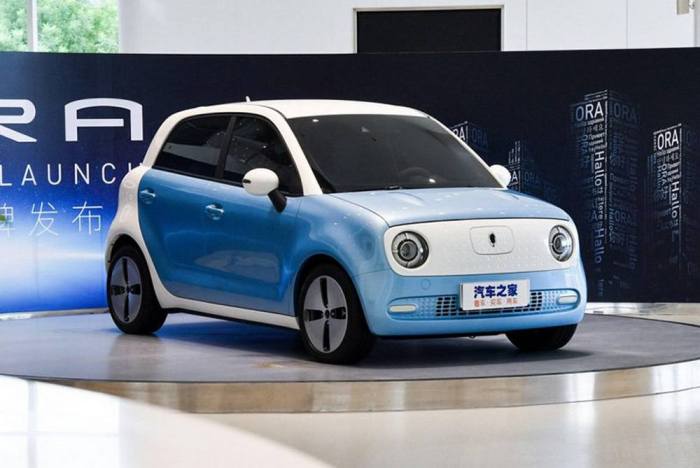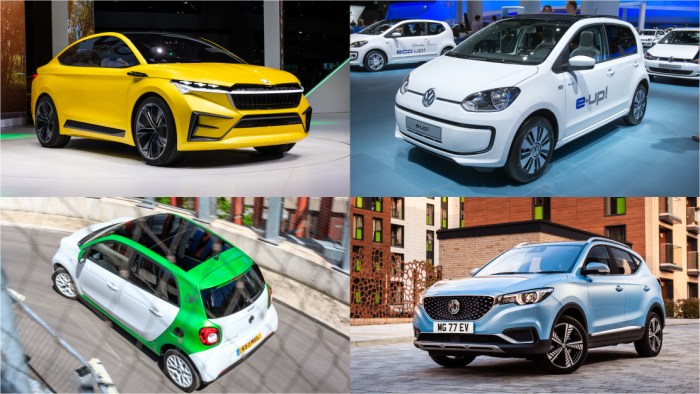Lowest Price New Electric Car A Comprehensive Guide
Defining “Lowest Price” in the Electric Vehicle Market: Lowest Price New Electric Car
Lowest price new electric car – Determining the absolute “lowest price” for a new electric car is more complex than simply looking at the sticker price. Several factors significantly influence the perceived affordability, creating a dynamic and often confusing landscape for potential buyers. This section will delve into these factors, providing a clearer understanding of how manufacturers’ suggested retail prices (MSRP) translate into real-world purchase prices.
Factors Influencing Perceived Lowest Price
The advertised price of an electric vehicle is rarely the final price. Trim levels, which determine features and specifications, significantly impact the cost. A base model will naturally be cheaper than a higher trim with added luxuries. Furthermore, regional pricing variations exist due to factors such as transportation costs, local taxes, and dealer markups. Incentives, including government subsidies and manufacturer rebates, further complicate the picture, making direct price comparisons challenging.
MSRP vs. Actual Purchase Price
The manufacturer’s suggested retail price (MSRP) serves as a starting point, but the actual purchase price often differs substantially. Dealers may offer discounts, negotiate prices, or add fees, affecting the final cost. For example, a car with an MSRP of $25,000 might be purchased for $22,000 after factoring in a manufacturer rebate and a negotiated price with the dealer.
Conversely, adding optional packages can easily push the price significantly above the MSRP.
Comparative Analysis of Pricing Strategies
Different electric vehicle manufacturers employ diverse pricing strategies. Some focus on offering a lower base MSRP to attract budget-conscious buyers, while others prioritize higher-end models with premium features and pricing to reflect their brand image. Tesla, for example, often uses a direct-to-consumer sales model with less negotiation room, while other manufacturers rely on a traditional dealer network that allows for more price flexibility.
Identifying Affordable Electric Car Models
Several electric vehicles currently offer competitive base MSRPs, making them attractive options for budget-minded consumers. The following table highlights some of these models, along with their key features. It is important to note that availability and pricing can vary by region and may change over time.
Table of Affordable Electric Car Models

Source: wordlesstech.com
| Make | Model | Base MSRP (USD) | Notable Features |
|---|---|---|---|
| (Example 1) | (Example Model 1) | (Example Price 1) | (Example Features 1) |
| (Example 2) | (Example Model 2) | (Example Price 2) | (Example Features 2) |
| (Example 3) | (Example Model 3) | (Example Price 3) | (Example Features 3) |
| (Example 4) | (Example Model 4) | (Example Price 4) | (Example Features 4) |
Specifications of Low-Priced Electric Vehicles
This section provides detailed specifications for three example low-priced electric vehicles, focusing on battery capacity, range, and charging times. Specific details will vary based on the chosen model and trim level. Always refer to the manufacturer’s specifications for the most accurate information.
(Example descriptions of three models’ battery capacity, range, and charging times would go here.)
Performance Comparison of Low-Cost Electric Cars
While prioritizing affordability, it’s crucial to consider the performance capabilities of low-cost electric cars. This section compares acceleration, top speed, and handling characteristics of three example models. Performance can vary considerably even within the same price range, so thorough research is vital.
(Example comparison of acceleration, top speed, and handling of three models would go here.)
Factors Affecting Affordability of Electric Vehicles
Several factors beyond the initial purchase price significantly influence the overall affordability of electric vehicles. This section explores the impact of government incentives, battery technology advancements, and the total cost of ownership.
Impact of Government Subsidies and Tax Credits, Lowest price new electric car

Source: edfenergy.com
Government subsidies and tax credits play a crucial role in making electric vehicles more affordable. These incentives can significantly reduce the upfront cost, making them more competitive with gasoline-powered vehicles. The availability and amount of these incentives vary by region and are subject to change.
Role of Battery Technology Advancements
Advancements in battery technology are a key driver in reducing the cost of electric vehicles. Improvements in battery energy density, lifespan, and manufacturing processes have led to lower production costs, ultimately translating into lower prices for consumers. The ongoing research and development in solid-state batteries promise further cost reductions in the future.
Calculating Total Cost of Ownership for an Electric Vehicle
A flowchart illustrating the calculation of the total cost of ownership for an electric vehicle would be included here. This would visually represent the various factors, including purchase price, electricity costs, insurance, maintenance, and potential battery replacement costs, to provide a comprehensive picture of long-term expenses.
(A detailed textual description of the flowchart, including all factors considered, would be provided here.)
Assessing Value for Money
Evaluating the value proposition of a low-priced electric vehicle requires a comprehensive comparison with both similarly priced gasoline-powered vehicles and used, higher-end electric vehicles. This section explores these comparisons, considering running costs and environmental impact.
Value Comparison: Low-Cost EVs vs. Gasoline Cars
A comparative analysis of three low-cost electric vehicles against comparable gasoline-powered cars would be presented here. This analysis would consider factors such as fuel costs, maintenance expenses, and environmental impact (emissions). The long-term cost savings and environmental benefits of electric vehicles would be highlighted.
(Example comparison of three low-cost EVs vs. three gasoline cars would be included here.)
Low-Priced EVs vs. Used Higher-End EVs: Pros and Cons
A list of pros and cons for purchasing a low-priced new electric vehicle versus a used, higher-end electric vehicle would be provided here. Factors to consider include initial cost, features, range, potential maintenance costs, and warranty coverage.
(A bulleted list of pros and cons for each option would be provided here.)
Potential Hidden Costs of Low-Priced Electric Cars
Potential hidden costs associated with owning a low-priced electric car, such as limitations in charging infrastructure access, potentially higher insurance premiums due to lower safety ratings in some cases, or higher repair costs due to less readily available parts, would be discussed here. This section aims to provide a realistic assessment of the overall cost of ownership.
Future Trends in Electric Vehicle Pricing
Predicting future trends in electric vehicle pricing requires considering several factors, including technological advancements, increasing demand, and evolving government policies. This section presents some plausible scenarios for the next 5-10 years.
Predictions for Electric Vehicle Prices (Next 5-10 Years)
Based on current trends in battery technology, manufacturing efficiency, and increasing competition, it’s reasonable to predict a continued decrease in the price of electric vehicles over the next 5-10 years. The rate of decrease may vary depending on the specific model and market conditions. However, a significant price reduction is anticipated, making EVs more accessible to a broader range of consumers.
This prediction is supported by historical trends in the electronics industry, where technological advancements consistently drive down prices over time.
Finding the lowest price new electric car requires thorough research. However, comparing prices across various brands is key, and understanding the pricing structures of established manufacturers like GMC is helpful. You can check out the current gmc car new model price to get a sense of the market. Ultimately, determining the absolute lowest price will depend on your specific needs and available incentives for electric vehicles.
Impact of Technological Advancements (Solid-State Batteries)
The development and widespread adoption of solid-state batteries are expected to have a significant impact on the affordability of electric vehicles. Solid-state batteries offer advantages in terms of energy density, safety, and lifespan, which should translate into lower production costs and potentially longer vehicle lifespans, reducing long-term costs.
Impact of Increasing Demand on Electric Vehicle Prices
While increased demand generally leads to higher prices, the impact on electric vehicle pricing is likely to be complex. Increased demand will stimulate manufacturing and innovation, potentially leading to economies of scale and lower production costs. However, if supply cannot keep pace with demand, prices could temporarily increase before stabilizing or decreasing as production scales up.
Visual Representation of Data
This section provides descriptions of visual representations of data related to electric vehicle pricing and cost of ownership. These visuals would help to further clarify the information presented earlier in the article.
Bar Graph: MSRP of Five Lowest-Priced Electric Cars

Source: newsd.in
A bar graph would illustrate the MSRP of the five lowest-priced electric cars currently on the market. The horizontal axis would represent the car models, while the vertical axis would display the MSRP in US dollars. Each bar would correspond to a specific model, with its height representing the MSRP. Clear labels and units would be provided for easy interpretation.
Pie Chart: Breakdown of Total Cost of Ownership
A pie chart would show the breakdown of the total cost of ownership for a low-priced electric car over a five-year period. The chart would be divided into segments representing different cost components, such as purchase price, electricity costs, insurance, maintenance, and potential battery replacement. Each segment would be labeled with the corresponding cost component and its percentage of the total cost of ownership.
Common Queries
What are the common hidden costs of owning a low-priced EV?
Hidden costs can include higher insurance premiums compared to gasoline cars, potential limitations with public charging infrastructure access (requiring home charging installation), and potentially higher repair costs due to specialized EV components.
How long do the batteries in low-priced EVs typically last?
Battery lifespan varies greatly depending on usage, charging habits, and climate. While manufacturers offer warranties, expect a significant reduction in battery capacity after several years, impacting range.
Are there any limitations on the range of low-priced EVs?
Yes, compared to higher-priced models, lower-priced EVs generally offer shorter ranges. This can restrict travel distances and require more frequent charging.





















